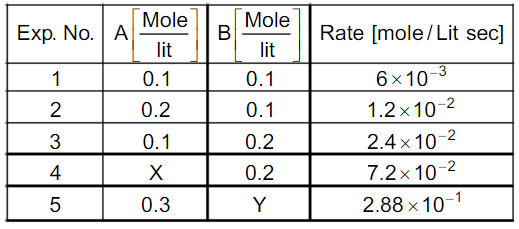A reaction A+B→C+D+q is found to have a positive entropy change, the reaction will be:
Possible at high temperature
Possible only at low temperature
Not possible at any temperature
Possible at any temperature
The correct Answer is:D
Step by step video & image solution for A reaction A +B rarr C+D +q is found to have a positive entropy change, the reaction will be: by Chemistry experts to help you in doubts & scoring excellent marks in Class 12 exams.
Updated on:21/07/2023Topper's Solved these Questions
- THERMODYNAMICS BOOK - ALLENCHAPTER - THERMODYNAMICS EXERCISE - EXERCISE -3
108 Videos
- THERMODYNAMICS BOOK - ALLENCHAPTER - THERMODYNAMICS EXERCISE - EXERCISE -4
18 Videos
- THERMODYNAMICS BOOK - ALLENCHAPTER - THERMODYNAMICS EXERCISE - EXERCISE -1B
22 Videos
- TEST PAPERSBOOK - ALLENCHAPTER - TEST PAPERSEXERCISE - MATHEMATICS
2 Videos
- Thermodynamics And Thermo ChemistryBOOK - ALLENCHAPTER - Thermodynamics And Thermo ChemistryEXERCISE - All Questions
40 Videos
Similar Questions
Knowledge Check
A reaction A+B→C+D+q is found to have a positive entropy change. The reaction will be
Apossible at high temperatureBpossible only at low temperatureCnot possible at any temperatureDpossible at any temperature.ΔG is the net energy available to do useful work and is a measure of free energy. If a reaction has positive enthalpy change and positive entropy change, under what conditions will the reaction be spontaneous?
AΔG will be positive at low temperature hence reaction is spontaneous at low temperature.BΔG is negative at high temperature hence reaction is spontaneous at high temperature.CΔG is negative at low temperature.DΔG is negative at all temperature hence reaction is spontaneous at all temperatures.In a reaction P+Q→R+S, there is no change in entropy, Enthalpy change for the reaction (ΔH) is 12 kJ mol−1. Under what conditions, reaction will have negative value of free energy change?
AIf ΔH is positiveBIf ΔH is negative.CIf ΔH is 24 kJ mol−1.DIf temperature of reaction is high
For the reaction
2A+B→C

Find X & Y.
View SolutionIn the reaction A+B→C+D, the concentration of A and B are equal and the rate of the reaction is rate =k[A][B]. The integrated rate equation for this reaction is
View SolutionFor a chemical reaction A→B, it is found that the rate of reaction doubles when the concentration of A is increased 4 times. What is the order of reaction ? Suggest the rate law also.
View SolutionFor the reaction A+B→C+D, doubling the concentration of both the reactants increases the reaction rate by 8 times and doubling the initial concentration of only B ismply doubles the reaction rate. What is the rate law for the reaction ?
View SolutionGiven the following diagram for the reaction A+B→C+D The enthalpy change and activation energy for the reverse reaction, C+D→A+B are respectively.

View Solution
